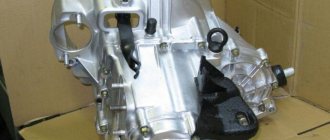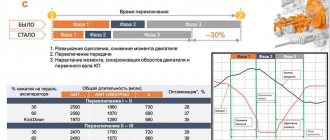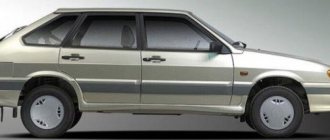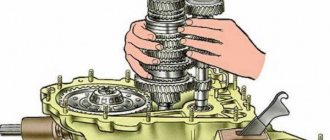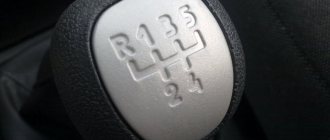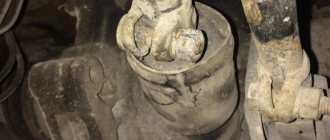Operating principle and troubleshooting of the VAZ 2110 gear shift mechanism
Like any car, the VAZ 2110 also has a gear shift mechanism.
The VAZ gearbox is five-speed, activated by a lever located in the car's interior. In order to be able to fix problems yourself, you need to understand a little about how exactly the switching mechanism works, which is why there are cases when some speed does not turn on or goes out. And also know how to fix it on your own.
Gear knob
The gearbox design is as follows:
- To ensure gear shifting, the gearbox contains a primary shaft consisting of a gear block. They are constantly engaged with the drive gears from the first to the fifth speed (that is, those that are oriented towards driving forward);
- The secondary shaft is equipped with a drive gear for the main transmission, and it also has gear synchronizers that ensure forward movement of the driven gears. There are also bearings plus an oil sump;
- VAZ two-satellite differential, with the driven gear of the main gear attached to the flange of its box;
- the gearbox drive consists of a gear shift knob, a ball joint, a selector rod, a rod, gear selection mechanisms, and gear shifting mechanisms;
- Jet thrust is designed to protect the gearbox from flying out of gear. Its ends are attached to the support and the power unit.
How to Engage Reverse Gear on a VAZ 2106
How to engage reverse gear on a VAZ 2106 Five-speed gearbox Five-speed gearbox.
1. Primary shaft;
2.4. Front cover of the box; 3. Input shaft oil seal; 4. Spring washer; 5. Bearing installation ring; 6. Box housing; 7. Thermostat VAZ 2106 in order to replace the thermostat on the VAZ 2106 car. Breather; 8. Needle bearing of the secondary shaft; 9. Synchronizer spring stubborn washer; 10. Work on removing the front door trim on a VAZ 2106. How to remove the trim on a VAZ 2107. Replacement. 5th gear synchronizer ring gear; 11. Sliding clutch for synchronizer of III and IV gears; 12. Synchronizer clutch hub for 3rd and 4th gears; 13. Synchronizer retaining ring; 14. Synchronizer blocking ring; 15. Synchronizer spring: 16. Gear is not the ring gear of the 3rd gear synchronizer; 17. The gear is not the ring gear of the 2nd gear synchronizer; 18. Secondary shaft; 19. The gear is not the ring gear of the 1st gear synchronizer; 20. 1st gear gear bushing; 21. Intermediate bearing of the secondary shaft; 22. Intermediate bearing locking plate; 23. Flange; 24. Protective cover; 25. Spring; 26. Gear shift lever; 27. Gear shift rod; 28. Elastic damper cushion; 29. Damper rubber bushing; 30. Damper spacer; 31. gear on VAZ 2109 and as reverse gear. turn on
. Damper locking sleeve; 32. Cuff; 33. Spherical washer; 34. Ball joint of the lever; 35.
Shift lever housing; 36. Guide plate; 37. Flange of the elastic coupling of the cardan transmission; 38. Nut; 39. Centering ring seal; 40. Centering ring; 41. Retaining ring: 42. VAZ classic timing chains and like locks on the doors of VAZ 2106 VAZ timing marks. Secondary shaft rear bearing oil seal; 43.
Protective bearing of the secondary shaft; 44. Speedometer drive gear; 45. Gear block bearing; 46. Gear block of 5th gear and reverse gear; 47. Reverse intermediate gear axis; 48. Reverse intermediate gear; 49. Rear intermediate shaft bearing; 50. Intermediate shaft 1st gear; 51. How to replace brake fluid on a VAZ 2114: Change it. Sliding clutch for synchronizer of 1st and 2nd gears; 52. Intermediate shaft II gear; 53. Third gear of the intermediate shaft; 54. Filler control hole plug; 55. Intermediate shaft; 56. Intermediate shaft constant mesh gear; 57. Front intermediate shaft bearing; 58. Intermediate shaft bearing clamping washer; 59. Clamp washer bolt; 60. Constant mesh gear of the input shaft; 61. Rear input shaft bearing; 62. Locking wheel; 63. Reverse locking bracket; 64. Guide plate washers; 65. Guide bar; 66. Cover of clamps; 67.
Retainer spring; 68. Latch; reverse fork
; 70. Thrust washer; 71. Retaining ring; 72. VAZ 2105, VAZ 2106, VAZ springs on the VAZ 2101 2105 have shortened springs, what do you think. 3rd and 4th gear shift fork; 73. Fork rod for 1st and 2nd gears; 74.
How to make a camber Ruler for adjusting toe on VAZ 2101, 2103, 2105, 2106 etc. 3rd and 4th gear shift fork rod; 75. Shift fork for 1st and 2nd gears; 76. Fork rod for 5th gear and reverse gear ; 77. Locking blocks. VAZ-21065 cars are equipped with a five-speed gearbox. It is created on the basis of a four-speed gearbox and differs in appearance by the shape of the rear cover, in the cavity of which the fifth stage is located at the end of the driven shaft. The introduction of an additional fifth gear has expanded the range of vehicle speeds, thereby achieving engine operation in the most economical modes, and also improving engine operating conditions.
Switching gears of a VAZ classic
In this video you will see how to change gears on a VAZ
classic. Maybe someone will find this video.
How to change gears on a VAZ, ZAZ
Lesson on gear shifting . This in turn increases the longevity of its operation. The gear ratios of the gears of the same name are the same for the five- and four-speed gearboxes. Fifth gear ratio. 0.82. Due to the fact that the five-speed gearbox is designed on the basis of a four-speed gearbox, many of its parts have the same structure and are interchangeable. The gearbox is also three-shaft, that is, it consists of 1 primary, 18 secondary and 55 intermediate shafts. The input shaft is identical to the shaft of the four-speed gearbox.
The secondary shaft is distinguished by its rear part, on which the fifth stage parts are located.
The intermediate shaft differs in that at the rear end it has a threaded hole for the bolt securing the block of 46 fifth gear and reverse gears. Driven gears 16, 17, 19 of the third, second and first gears, synchronizer parts, shaft bearings are unified with the same parts of the four-speed gearbox. Thus, the design of the parts located in the cavity of the box housing is the same as the four-speed gearbox. The fifth gear and reverse parts are located in the cavity of the rear cover. Together with the reverse driven gear 12, the hub 13 of the fifth gear synchronizer clutch 14 is secured to the driven shaft 2 with one key. Behind the hub 13 there is a thrust washer and a bushing 18, on which the fifth gear gear 17 rotates. An oil deflector washer 19 is clamped between the gear sleeve 17 and the drive gear 20 of the speedometer drive.
It reduces the release of oil towards the oil seal 42, improving its operating conditions. The rear end of the secondary shaft rotates on a cylindrical roller bearing 43, because the load on the rear end of the shaft has increased. The flange 37 of the elastic coupling is attached to the shaft splines. All parts located on the secondary shaft are tightened with a nut 38, which is secured with a lock washer.
On the cylindrical belt of the nut there is a rubber seal 39, and at the end of the shaft there is a centering ring 40 and its retaining ring. The block 46 of the fifth gear and reverse gears is secured to the splines of the intermediate shaft 55 with a coupling bolt. The rear support for the gear block is a cylindrical roller bearing 45. The gear block has two crowns. The large crown is in constant mesh with the fifth gear driven gear. The intermediate gear 48 engages with the small ring when reverse gear is engaged. The intermediate gear 48 is located on the axis 47, which is secured in the crankcase partition with a nut and a spring washer. The other end of the axle rests in the socket of the rear cover.
The gear shift drive also differs slightly from the drive of a four-speed gearbox. The design of the rod 76 and fork 69 for engaging reverse and fifth gears has been changed.
A double fork 69 is attached to the rod 76 with a locking bolt. It fits into the groove of the reverse intermediate gear 48, the other one. into the annular groove of the fifth gear synchronizer clutch. Thus, when the rod 76 moves, the same fork will engage one or another gear. In this regard, rod 76 has three slots for locking balls, just like other rods. The fork 69 has a groove into which the lower end of the gear shift lever fits.
At the end of the rod 76, a head is attached with a locking bolt, on which there is a flat, with which the head acts on the rod (ball) of the reversing light switch.
In the future, when changing the design of the drive, it is planned, together with the rod head, to make a boss with a groove for the lower end of the gear shift lever, removing this boss from the fork 69. Using the VAZ 2114 as an example. HOW TO CHANGE THE BRAKE FLUID change the brake fluid? A new gear selection mechanism has been introduced into the gear shift drive. It blocks accidental engagement of reverse gear when engaging fifth gear. The gear selection mechanism consists of a lever guide plate 36, upper and lower guide plate washers 64, and a gear shift
, reverse locking bracket 63. The listed parts are secured with three bolts that secure the selector mechanism to the socket of the rear gearbox cover.
In the grooves of the guide plate 36, spring-loaded guide bars 65 are installed, between which the lower end of the gear shift lever is clamped. valves on the VAZ 2106 engine. VAZ 2106 valve stem seals how to use it.
Under the action of the springs of the guide plates, the gear shift lever is set to the neutral position, in which the end of the lever is located in the groove of the head of the rod 74 for selecting 3rd and 4th gears. When turning off 5th gear, if the lever crosses the line of the neutral position, the protrusion of the lever will rest against the bent petal of the locking bracket 63 and further movement of the lever towards reverse gear stops. This prevents accidental engagement of reverse gear while the vehicle is moving and damage to gearbox parts. To engage reverse gear, push the lever down to compress its spring.
In this case, the protrusion of the lever will drop below the petal of the locking bracket 63, and you can move the gear shift lever back until the reverse gear is fully engaged.
Adjustment
On a VAZ 2110, it is not so uncommon for the gears to shift poorly or get knocked out. A mechanism for adjusting the speed selection drive is provided specifically for this purpose.
Adjustment may be necessary if:
- the box was recently removed for repairs;
- one of the gears falls out;
- the speeds do not engage well or simply get knocked out when the car is moving.
If you have one of these problems, try making adjustments first. Its sequence:
- Under the bottom of the VAZ 2110, find and slightly loosen the nut on the bolt that tightens the clamp that secures the rod designed to control the gearbox;
- Use a screwdriver to slightly move apart the grooves in the end of the rod and the resulting gap on the clamp itself. This is necessary to ensure easy movement of the rod in relation to the gear selection rod. Place the rod in the neutral position;
- Release the shift knob from the cover in the cabin;
- Align the lever using a special template. This is done like this: install a template in the window of the rear speed lock bracket lining. After this, insert the lever axis stop into the groove of the template, pressing it without unnecessary force in the transverse direction;
- Then adjust the axial play of the rod in the rear direction, and its axial play by turning to the left;
- Install the clamp, not reaching a few millimeters from the end of the rod. Then tighten the clamp thoroughly with the bolt.
If the described adjustment did not help you, you need to remove and disassemble the VAZ 2110 gearbox. Pay special attention to the fact that the gears with which the first and second speeds are engaged often knock out. Be sure to check each fastener.
They are made in the form of springs, there are three of them. The first clamp is long, it is responsible for first and second gears. Second is medium, for third is fourth gear. For the fifth, the shortest clamp is used.
Checkpoint diagram
- the second one flies out most often because the gear teeth do not mesh well with the clutch that turns on the speeds;
- The tips of the gear teeth and clutch are already worn out, so the speed is difficult to engage. If you don’t intervene, it will soon fly out;
- as an option, when it knocks out on bumps, the clutch dies.
Repair
In order to be able to fix problems yourself, you need to understand a little about how exactly the switching mechanism works, which is why there are cases when some speed does not turn on or goes out. And also know how to fix it on your own.
The article is written taking into account a manual gearbox with synchronizers, i.e. an ordinary “handle”, which is installed on almost all cars from Nine to Zonda. The materials for this article were collected from many professional sources.
First, we will explain what a gas booster is and why it is needed. Imagine that you are driving 60 km/h... Suddenly a fancy Sky with neon lighting “flies up” to you from the left and starts honking and accelerating. Of course, your action is to move on and I’m not in a hurry. But suppose you decide to answer the “challenge”. You need to shift from 5th gear to 2nd. If you simply depress the clutch, engage 2nd gear and release the clutch, the car will jerk very strongly, and the clutch with the gearbox will have a hard time. Why is this happening?
You might be interested ==> Living wage for pensioners in Kurgan in 2021
To avoid this, it is necessary to add gas, i.e. press the gas a little before releasing the clutch. This is done very quickly: the foot hits the gas pedal, in our case quite deeply, almost to the floor, and instantly releases it. Immediately the clutch is released, and the right foot presses on the gas again, but this time to accelerate. The purpose of accelerating in this case is to raise engine speed to 5000 rpm or a little higher. If you do everything correctly and then quickly release the clutch, you will not feel anything at all, and the car will begin to smoothly accelerate when you press the gas again.
The clutch pedal must be pressed sharply, this disengages the clutch, disconnects the rotation of the crankshaft and the input shaft of the gearbox; Hold the steering wheel with your left hand, and with your right hand move the gear shift lever to the first or second gear position (when it is necessary to engage second gear, we will consider below). Comment. The first (second) gear may not engage immediately; there is no need to try to push it in by force. Move the gear shift lever to the neutral position, release the clutch pedal, depress the clutch pedal all the way again and repeat engaging the first (second) gear. At the same time, the gears of the gearbox have turned and the gear should engage easily; again carefully inspect the road through the mirrors and left shoulder, make sure it is safe once again; If you can start moving, then release the parking brake lever down; lightly press the gas pedal with your right foot; feel the crankshaft speed increase slightly.
This position is recommended when driving on mountain roads. This makes better use of engine power and increases the engine braking effect. The transmission automatically shifts between first and second gears. Third and fourth gears are locked.
2.32 Gear shift
The main forces are: the rolling resistance force of the wheels, the air resistance force, the inertia force and the lifting resistance force. The movement of the car is ensured when the adhesion force between the wheels and the road is equal to or greater than the traction force. If the traction is greater than the traction force (the ten has more traction force than most other domestic cars), then the drive wheels will slip. In this case, a large load is placed on the clutch and gearbox, which can quickly fail. Fans of a sporty driving style should especially remember this. On the 10, the gearbox is not from a Mercedes.
- Under the bottom of the VAZ 2110, find and slightly loosen the nut on the bolt that tightens the clamp that secures the rod designed to control the gearbox;
- Use a screwdriver to slightly move apart the grooves in the end of the rod and the resulting gap on the clamp itself. This is necessary to ensure easy movement of the rod in relation to the gear selection rod. Place the rod in the neutral position;
- Release the shift knob from the cover in the cabin;
- Align the lever using a special template. This is done like this: install a template in the window of the rear speed lock bracket lining. After this, insert the lever axis stop into the groove of the template, pressing it without unnecessary force in the transverse direction;
- Then adjust the axial play of the rod in the rear direction, and its axial play by turning to the left;
- Install the clamp, not reaching a few millimeters from the end of the rod. Then tighten the clamp thoroughly with the bolt.
You might be interested ==> Russian Railways benefits for schoolchildren 2021
CPT diseases
VAZ 2110 owners often complain that the first gear is difficult to engage or crashes.
- often the synchronizer is to blame;
- perhaps the clamp spring has burst, the lever is hanging loose, the speeds are switched on as desired;
- The stem and fork may need replacement.
Another complaint is that second gear is difficult to engage and often gets knocked out.
Here you can suspect the main culprits:
- the second one flies out most often because the gear teeth do not mesh well with the clutch that turns on the speeds;
- The tips of the gear teeth and clutch are already worn out, so the speed is difficult to engage. If you don’t intervene, it will soon fly out;
- as an option, when it knocks out on bumps, the clutch dies.
Sometimes (albeit rarely) when the second one does not turn on well enough and falls out, replacing the retaining spring helps. If the speeds often drop out, some of them are difficult to turn on, which means that half-measures will no longer help - the box needs to be overhauled.
Whether you do it yourself, or go to a service center where they will repair it for you and also adjust the gear shift mechanism, decide for yourself, based on your own experience and skills.
Getting to know the gearbox
To improve the operation of the system, you should place the regulators in the extreme position (0) and remove them. Then you will have to spend time removing the front cover and glass from the latches. After this, you need to get rid of all fasteners, in particular, 2 front and 1 rear screws.
Operation, repair and maintenance
The car's highest torque is in first gear. It is not difficult for the engine to rotate the wheels, but the speed of the car will not exceed 40 kilometers per hour. When such a speed is reached, the tachometer needle is usually in the red scale. Therefore, to move further, you need to switch to a weaker but faster gear. Then to the third, quadruple and so on. All switching must be done sequentially. The engine power is not enough to confidently accelerate the car at 20 kilometers in 3rd gear. Unless, of course, it's a 5.0-liter V-8.
You might be interested ==> What are the payments from 3 to 7 years in 2021 in the Kemerovo region?
Every car owner is familiar with the VAZ-2110. Despite the fact that production stopped a long time ago, these models are still actively used in small provincial towns and villages. The car in all available trim levels was equipped with a manual transmission. Few owners think about installing a VAZ-2110 gearbox. However, it is very useful to know what this mechanism consists of, what “congenital diseases” it has, and how to repair it.
These marks are marked on the dipstick as the minimum and maximum values. Next, you will need to start the engine and wait until the oil light (or oil pressure light) goes out. After this, turn off the engine, check the oil level and, if necessary, remove excess or add more oil.
Installation and repair of VAZ 2110 gearbox
It also happens that transmissions go out. If they turn off while driving, then it is worth checking the condition of the engine mounts. Vibrations may cause gear shifts. If the speeds are not switched on as easily as before or if there are characteristic sounds, then this indicates worn out synchronizers. For repairs, you need to know exactly the structure of the VAZ-2110 gearbox.
The transmissions turn off on their own. This malfunction may be associated with wear or damage to the gear teeth, loosening of the second shaft nut, wear of the rods and deformation of the forks, as well as increased vibration of the motor during operation. To solve the problem, you need to replace the faulty elements and adjust the drive.
How to change speeds on a VAZ 2110
Correct gear shifting. Tell?!
Post by KLASSIK072 » 24 Oct 2010, 00:19
Auto VAZ 2110, tell me how to change gears and operate the clutch correctly?!

